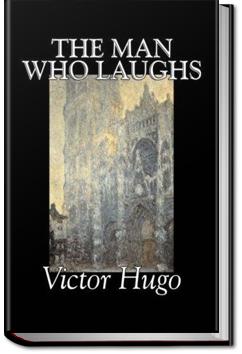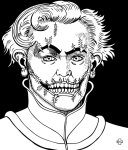THE MAN WHO LAUGHS (1869) – Written by Victor Hugo.
 I always commit the literary blasphemy of saying that I don’t consider Victor Hugo’s The Hunchback of Notre Dame to be very much of a horror story. I will forever maintain that Hugo’s overlooked novel The Man Who Laughs features all the virtues of Quasimodo’s tale AND presents them all in a superior fashion.
I always commit the literary blasphemy of saying that I don’t consider Victor Hugo’s The Hunchback of Notre Dame to be very much of a horror story. I will forever maintain that Hugo’s overlooked novel The Man Who Laughs features all the virtues of Quasimodo’s tale AND presents them all in a superior fashion.
In addition The Man Who Laughs contains many more elements that lend themselves to pure horror than does The Hunchback of Notre Dame. In the past I’ve examined elements of the film adaptations of The Man Who Laughs (including the fact that the physical appearance of Batman’s foe the Joker was inspired by Conrad Veidt’s 1928 portrayal of the title figure.)
Here’s a breakdown of why I prefer TMWL, with Hugo’s tragic monster Gwynplaine to THOND, with his tragic hunchback Quasimodo:
 TIME PERIOD: The Man Who Laughs has the action set mostly in England in 1705. For Gothic Horror I prefer that time period to the late 1400s, when The Hunchback of Notre Dame takes place.
TIME PERIOD: The Man Who Laughs has the action set mostly in England in 1705. For Gothic Horror I prefer that time period to the late 1400s, when The Hunchback of Notre Dame takes place.
ORIGIN OF THE TITLE CHARACTER: Quasimodo the hunchback was simply born in a deformed state.
Gwynplaine on the other hand, was born looking normal, but was stolen away and sold by villains to the Comprachicos, evil anatomists who distorted the bodies of children in very painful ways.
The Comprachicos would artificially create “monsters” by molding the still-developing bodies of children. (Think of the custom in some cultures of using weighted boards to distort the shape of an infant’s head for an example.) By keeping the children imprisoned in tight vices or wires they could create hunchbacks or dwarves or otherwise malformed “human novelties.”
By breaking and resetting certain bones in the childrens’ anatomies they could fashion chicken-boys and chicken-girls, or frog-boys and frog-girls or – more magnanimously – exceptionally nimble acrobats and contortionists.
Acids and crude surgery could sculpt the unfortunate children into skull-faced monstrosities or worse. Cultivating supporating wounds in the bodies could create freaks with bodily holes that permitted gawkers to see some of their internal organs.
Obviously the biggest customers for these sadistically damaged humans were aristocrats, the wealthy, carnivals and sideshows. Just as obviously many of these pitiful people would die very young, sometimes from the tortuous treatments being inflicted on their growing bodies.
Gwynplaine was sold to the Comprachicos at age two because he was the heir to a British nobleman. Conspirators wanted to get him out of the way in favor of another child of the nobleman. The Comprachicos subjected Gwynplaine’s face to treatments that disfigured it, making him incredibly hideous and leaving his lips and facial muscles distorted into a perpetual insane smile.
The young Gwynplaine was also used like a pack animal, endowing him with enormous strength from the constant exercise. In his twenties when the main story begins in 1705 Gwynplaine’s huge draw as a carnival freak is the contrast of his horrific face with his muscular, Adonis-like body.
PERSONALITY: Quasimodo was deaf from ringing the bells at Notre Dame Cathedral, was half-blind and was very simple-minded. To me that makes him too limited a figure.
Gwynplaine possessed intelligence and eloquence that made him a far more sympathetic and versatile character. His poetic way of speaking is employed very touchingly to describe the monstrously cruel way that the Comprachicos create freaks like him. His bitterness toward the gawking carnival audiences is very well expressed, too.
That eloquence is useful later in the story when he denounces the disparity between the pampered upper classes and the suffering lower classes in England. Gwynplaine can understand the events of his story far better than Quasimodo can understand his.
FEMALE LEAD: Esmeralda the Gypsy dancer from The Hunchback of Notre Dame is too much of a Mary Sue to me. Every male character falls in love with her or lusts after her and her over-complicated relationships with each of them get laughable after a while in my opinion.
Dea the blind girl from The Man Who Laughs provides us with the fictional archetype of the sightless woman unable to see a monstrous character’s deformities, and therefore falling in love with their inner beauty. In addition she combines the best features of Cosette from Hugo’s Les Miserables and Hunchback‘s Esmeralda herself without Esmeralda’s annoying perfection.
ANTAGONISTS: Okay, I’ll call this element a draw because I do admire Victor Hugo’s way of depicting the villainy of the Holy Rollers and supposedly “decent” public figures in Hunchback.
I will say, though, that for the time period it’s an interesting change of pace the way the Duchess Josiana has a lustful fetish for Gwynplaine’s kinky blend of a hideous face but manly body.
As for the rest of the respective stories I think The Man Who Laughs provides better opportunities than The Hunchback of Notre Dame for horror and for subtext about what truly constitutes a monster.
The elements of exploitation, societal injustice and implied pornography work well, too, especially the way Duchess Josiana is happy to regard Gwynplaine as a convenient outlet for her secret lusts and hungers but is repulsed at the thought of a marriage to him when his aristocratic lineage is discovered.
For newcomers to the tale of Gwynplaine various court intrigues wind up separating him from Dea, who is even told that her true love (our hero) is dead. The deformed freak witnesses a new breed of horror in the lives of the aristocrats his noble heritage deposits him among. The British aristocracy’s treatment of the commoners at times rivals the cruelty of the Comprachicos.
I’ve long wished that David Lynch had directed a black and white film version of The Man Who Laughs instead of The Elephant Man way back when. Any number of directors could have done justice to The Elephant Man but I think Lynch alone was qualified to give the world the definitive adaptation of Gwynplaine’s saga.
The carnival freak show elements, the literal and metaphorical significance of the Comprachicos and Duchess Josiana’s bizarre arousal over Gwynplaine’s monstrous face were tailor-made for Lynchian weirdness. Too bad we’ll apparently never get to see what he would have done with this story.
As a fan of cult movie figures I’m always reminded of the sad story of Rondo Hatton whenever I re-read The Man Who Laughs.
FOR ISABELLA OF EGYPT, FEATURING A GOLEM, A MANDRAGORE, A LIVING DEAD MAN, A GYPSY WITCH AND A JEWISH SORCEROR CLICK HERE
FOR MORE HALLOWEEN ITEMS CLICK HERE: https://glitternight.com/category/halloween-season/
© Edward Wozniak and Balladeer’s Blog 2015. Unauthorized use and/or duplication of this material without express and written permission from this blog’s author and/or owner is strictly prohibited. Excerpts and links may be used, provided that full and clear credit is given to Edward Wozniak and Balladeer’s Blog with appropriate and specific direction to the original content.

What a sad and scary story.
You said it!
Very sad and scary what people will do to each other.
I know exactly how you feel.
Gross and too scary to think about!
I know how you feel.
It’s ugly when children are in a horror story.
I agree.
I’m enjoying all the forgotten stuff you write about!
Thanks!
Those poor children!
I agree.
Gwynplaine should be a Halloween cosplay staple!
I agree, especially since you can buy artificial Glasgow Smiles.
Your rite Lynch should have done this instead of Elephantman.
Yep! I think it would have been hauntingly beautiful.
I’m not that much of a online reader to be honest but your blogs really nice, keep it up! I’ll go ahead and bookmark your website to come back down the road. All the best